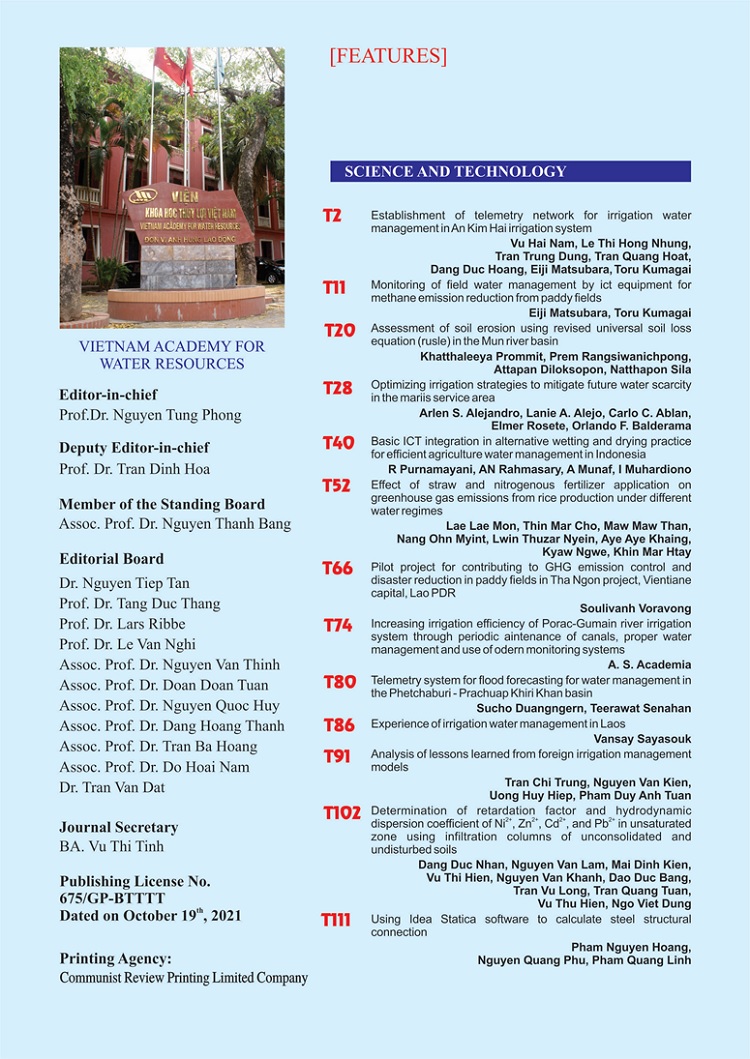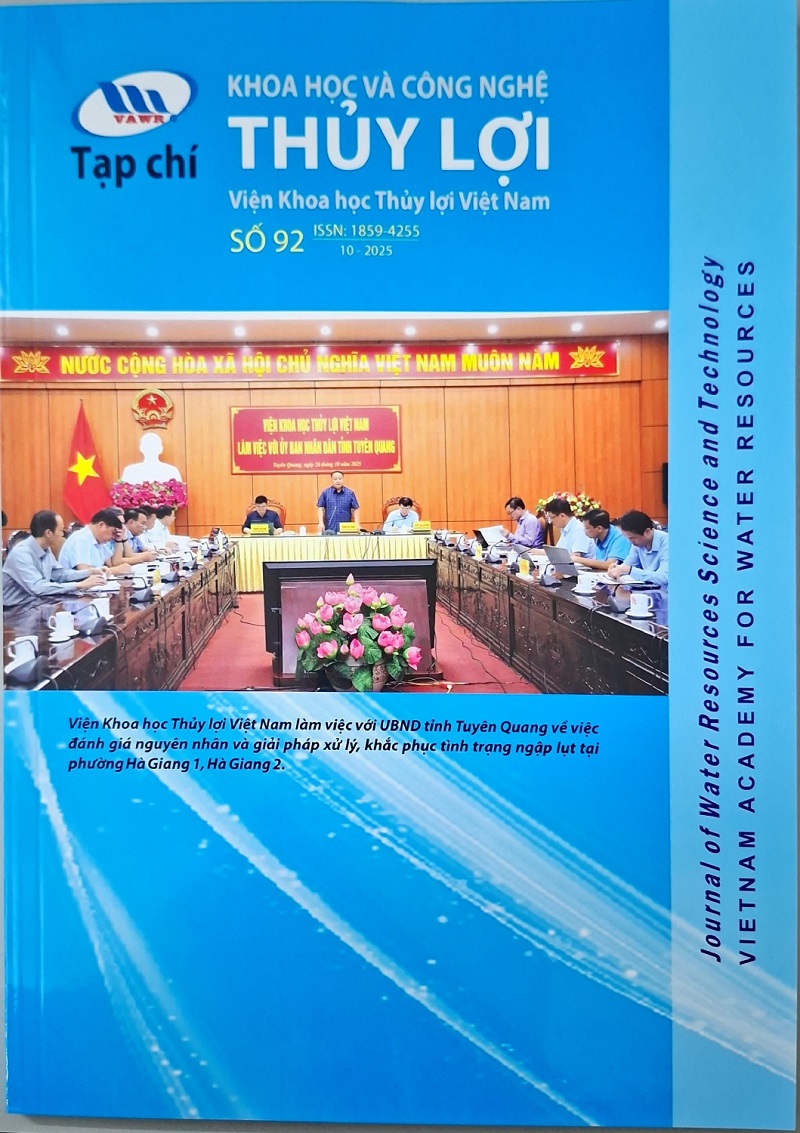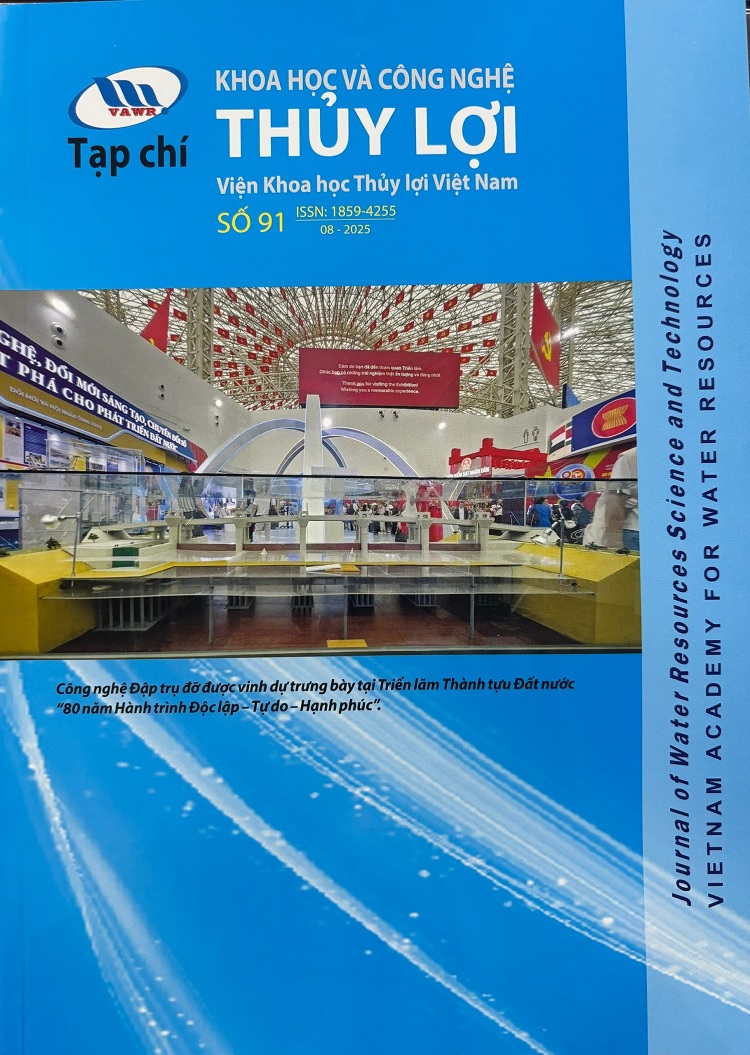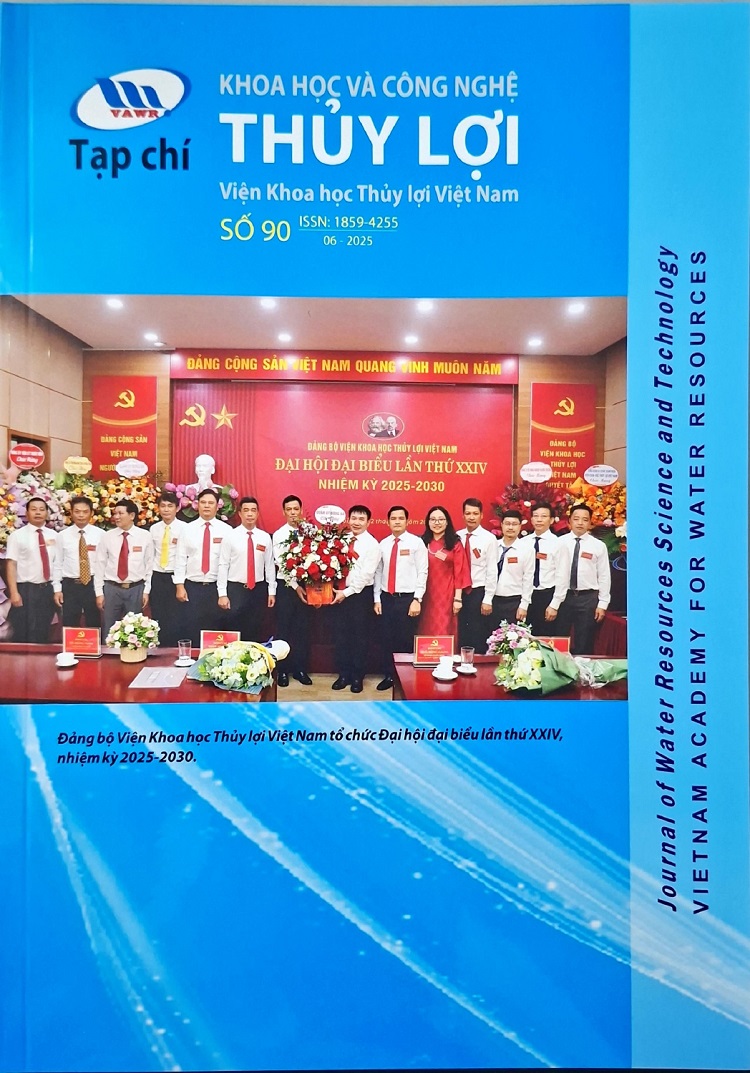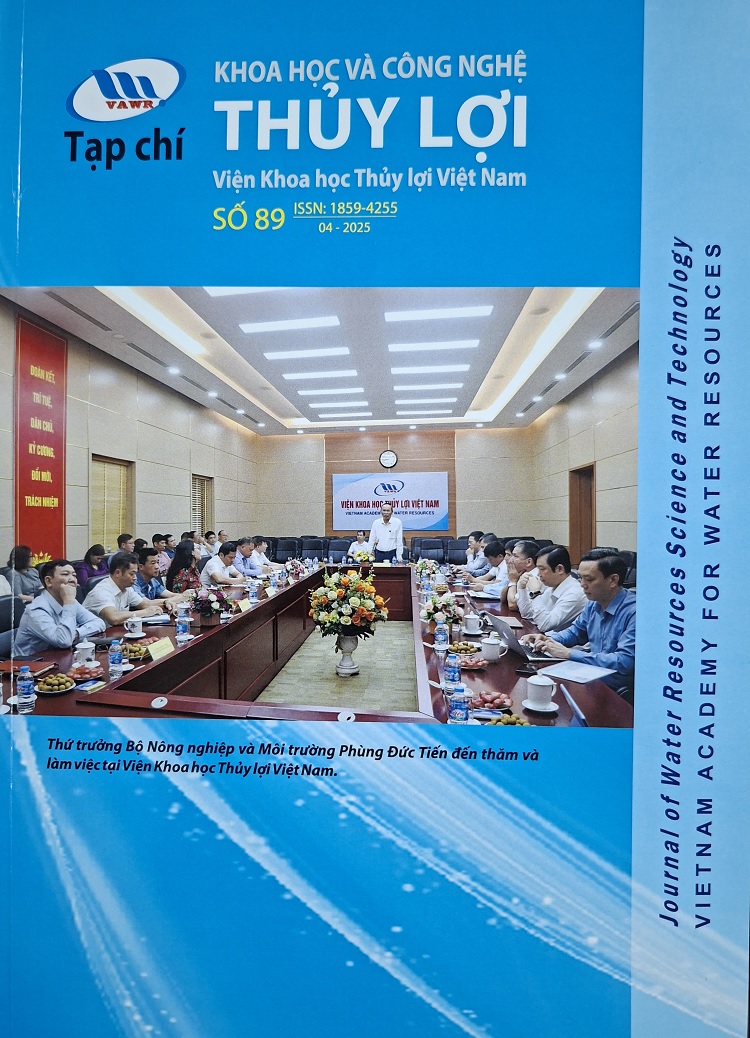Page | Title | Authors | Abstract |
2 | Establishment of telemetry network for irrigation water management in An Kim Hai irrigation system | Vu Hai Nam1, Le Thi Hong Nhung1, Tran Trung Dung1, Tran Quang Hoat2, Dang Duc Hoang2, Eiji Matsubara3, Toru Kumagai4 1. Vietnam Academy for Water Resources (VAWR), Vietnam 2. An Hai Irrigation Management Company, Vietnam 3. Japan Association for International Collaboration
of Agriculture and Forestry (JAICAF), Japan 4. Agricultural Development Consultants Association (ADCA), Japan | In Vietnam's irrigation systems, telemetry-based water level and weather observation facilities have been installed at dams, headworks, important gates, etc., but there have been no cases of forming a telemetry (TM) network in an irrigation system (IS) and monitoring water level data for the entire command area. The JAIF1 project installed TM equipment in the South Nghe An irrigation system (SNA-IS) in Nghe An Province in 2019 for pumping irrigation. In 2024, TM equipment was installed in the An Kim Hai irrigation system (AKH-IS) for gravity irrigation within the JAIF2 project, forming an TM-based water management network. As a result, a model of gravity irrigation with gate operation in the AKH-IS was established. It is expected that this will contribute to the efficient operation of the numerous gates to stabilize water supply to Hai Phong city as well as irrigation. In addition, the TM data display system (VAWR system) was developed by the VAWR so that personnel in charge can easily check TM data on their smartphones or tables. With the TM data display system, all concerned parties will be able to monitor TM data on a daily basis and use it for appropriate gate management and disaster prevention. Keywords: Telemetry, TM, JAIF, TM data display system, VAWR system. |
11 | Monitoring of field water management by ICT equipment for methane emission reduction from paddy fields | Eiji Matsubara1, Toru Kumagai2 1. Japan Association for International Collaboration
of Agriculture and Forestry (JAICAF), Japan 2. Agricultural Development Consultants Association (ADCA), Japan | Vietnam is one of the world's largest rice exporters. The cropping area of rice reaches 7 million hectares. The annual GHG emissions from rice production account for about half of the agricultural sector, and methane from paddy fields is around 3/4 of the national emissions. Reducing methane emissions from paddy fields can be achieved by introducing intermittent irrigation, which temporarily exposes the field to the air during the cropping period, eliminating anaerobic conditions. The Agricultural Development Consultants Association (ADCA) has started a demonstration test of intermittent irrigation, in An Hoa Commune, An Duong District, Hai Phong City. In this test, farmers are asked to fill out simple rice production records and, with their consent, they are asked to carry out intermittent irrigation. The situation is monitored with a paddy water level sensor and a camera, and problems / solutions such as reduced yields and increased water management labor are examined. Ultimately, methods for promoting intermittent irrigation and the possibility of converting emission reductions into carbon credits similar to Japan's J-Credit will be examined. In addition, as part of climate change adaptation measures, simple underdrainage construction technology will be introduced, and the possibility of improving resilience by diversifying paddy field use and diversifying crops will be examined. Keywords: Methane, LPWA, J-Credit, DNDC-Rice model. |
20 | Assessment of soil erosion using revised universal soil loss equation (rusle) in the Mun river basin | Khatthaleeya Prommit1,2*, Prem Rangsiwanichpong1, Attapan Diloksopon2, Natthapon Sila2 1. Department of Water Resources Engineering,
Faculty of Engineering, Kasetsart University, Bangkok, Thailand 2. Royal Irrigation Department, Thailand | Soil erosion is a natural disaster resulting from the movement of soil, rocks, and debris down a slope due to the force of gravity. This process typically follows natural events such as flash floods, earthquakes, or severe rainstorms, which destabilize the soil. Soil erosion often occurs when elements like water and wind increase the soil's weight or weaken the bonds between soil particles, leading to their displacement or collapse. This study focuses on evaluating soil erosion in the Mun Basin, both historically and in the present day, using the Revised Universal Soil Loss Equation (RUSLE). By calculating sediment levels based on past annual rainfall data and assessing soil erosion across return periods of 5, 10, 50, 100, 500, and 1,000 years, the study highlights the significant impact of rainfall on erosion rates, particularly in agricultural areas. Furthermore, the study aims to develop a soil erosion hazard map to help predict and mitigate potential impacts. Keywords: GIS, RUSLE, Soil Loss, Spatial analysis, Thailand. |
28 | Optimizing irrigation strategies to mitigate future water scarcity in the mariis service area | *Arlen S. Alejandro1, Lanie A. Alejo2, Carlo C. Ablan3, Elmer Rosete4, Orlando F. Balderama5 *1,3. National Irrigation Administration-MARIIS Dam
and Reservoir Division, Ramon, Isabela Philippines 2,4,5. Isabela State University, Echague, Isabela, Philippines | This study aims to enhance irrigation management within the Magat River Integrated Irrigation System (MARIIS) by employing interventions and optimizing water use. An existing water demand and supply model coupled with a hydrological model was adopted as the basis for evaluating irrigation improvement scenarios, including the effects of key interventions. Data collected from the telemetry system played a crucial role in accurately modeling water resource dynamics, ensuring a reliable foundation for the study's findings. The results reveal the significant impact of infrastructure improvements and management strategies implemented between 2021 and 2023, particularly the increased conveyance efficiency (CE) through canal lining and the gradual adoption of Alternate Wetting and Drying (AWD) practices. Despite the slow uptake of AWD, these interventions have notably expanded irrigated service areas and improved water distribution efficiency. The study highlights the importance of continuing to enhance CE and promoting AWD to mitigate water scarcity, strengthen resilience to climate change, and improve integrated water resource management. These findings offer critical insights for policymakers and water managers aiming to sustain agricultural productivity in the face of increasing water demands and environmental challenges. Keywords: Irrigation management interventions, telemetry, climate change, conveyance efficiency, Alternate Wetting and Drying (AWD) |
40 | Basic ICT integration in alternative wetting
and drying practice for efficient agriculture water management in Indonesia | R Purnamayani1, AN Rahmasary1, A Munaf1, I Muhardiono1 1. Agency of Agricultural Instrument Standardization, Indonesia | Indonesia faces significant agricultural challenges, including water scarcity and inefficient irrigation, necessitating increased rice productivity. The integration of basic Information and Communication Technology (ICT) into the Alternate Wetting and Drying (AWD) practice offers a promising solution. Unlike advanced ICT solutions that can be expensive and require sophisticated tools, basic ICT provides cost-effective and accessible options for farmers. Simple tools, such as homemade water level sensors, enable easy monitoring of soil moisture levels and optimization of irrigation schedules. This user-friendly technology supports optimal crop growth conditions while conserving water. Additionally, the simplicity of basic ICT makes it easier to scale up the technology across different regions, facilitating wider adoption among farmers. Implementation in Patokbeusi in Subang Regency showed that AWD saves 12% more water, using 670 m³ compared to 760 m³ for CF methods, without compromising rice yields. By adopting these affordable technologies, Indonesian farmers can overcome water management challenges, improve rice production, and ensure agricultural sustainability. Keywords: Irrigation efficiency, alternative wetting and drying, ict in agriculture |
52 | Effect of straw and nitrogenous fertilizer application on greenhouse gas emissions from rice production under different water regimes | Lae Lae Mon1, Thin Mar Cho1, Maw Maw Than1, Nang Ohn Myint1, Lwin Thuzar Nyein1, Aye Aye Khaing1, Kyaw Ngwe1 and Khin Mar Htay1 1. Ministry of Agriculture, Livestock and Irrigation of Myanmar | Two experiments were conducted in Department of Agricultural Research, Naypyitaw, Myanmar, during the summer seasons of 2019 and 2020 to study methane (CH4) and nitrous oxide (N2O) emissions related to global warming potential (GWP) and to observe rice yield under different water regimes and nitrogen fertilizer applications, with and without straw incorporation. The experiments used a split-plot design with three replications. The main plots included two water regimes: Continuous Flooding (CF) and Alternate Wetting and Drying (AWD). The subplots featured five treatments: Control, Urea, Ammonium Sulfate, Straw + Urea, and Straw + Ammonium Sulfate. Gas sampling and analysis were conducted using the closed chamber method. The results indicated that CH4 emissions significantly contributed to GWP, with 62-97% in 2019 and 85-99.4% in 2020. AWD reduced CH4 emissions by 64-69% and GWP by 60-66% compared to CF in both years. Straw incorporation increased CH4 emissions, GWP, and yield-scaled GWP. Even with straw incorporation, AWD resulted in lower GWP and yield-scaled GWP compared to CF. Ammonium sulfate was more effective than urea in reducing CH4 emissions, GWP, and yield-scaled GWP under both water regimes. Thus, using ammonium sulfate under AWD conditions is recommended for mitigating greenhouse gas emissions and enhancing rice productivity. Keywords: Global warming, methane, nitrous oxide, rice production, water management. |
66 | Pilot project for contributing to GHG emission control and disaster reduction in paddy fields in Tha Ngon project, Vientiane capital, Lao PDR | Soulivanh Voravong1 1. Deputy Director of Irrigation and Drainage Development Division,
Department of Irrigation, MAF, Lao PDR | The pilot project (field demonstration) is a supporting from Japanese government by Official Development Assistance (ODA) and through Japan Water Agency (JWA), these programs will be field demonstrations for two countries (Cambodia and Laos) as per JWA’s proposal, the promotion of climate change adaptation and mitigation measures in the through agriculture and rural development in Asian Monsoon region (for Cambodia and Laos) is a presented of the JWA and will be implemented in the Tha Ngon Irrigation project in Laos. And also the filed demonstration will be integrated methodologies including the alternate wetting and drying (AWD) - reduce Irrigation water consumption and greenhouse gas emissions by drying paddy filed soil to 15 cm below the surface, and then re-flood the paddy fields with 5 cm of water, repeating the process several times during one cropping season., Paddy Field Dam - Paddy field dam is expected to alleviate flood damage in the downstream area by temporarily storing storm water during heavy rainfall, and Information Communication Technology (ICT- Based water management system) - Automated water management for paddy fields. The main objective of the project for installation of the ICT tools for the field demonstration on the water management in the rice fields, evaluation and analysis of adaptation and mitigation measures of effects of introducing climate change adaptation and mitigation measure technologies, preparation of work concepts for agricultural and rural development in Cambodia and Laos and proposal to the government agencies in these countries, and preparation of reference documents on climate adaptation and mitigation measure technologies for overseas development, and holding the workshop for countries in the Asian monsoon region including Laos and Cambodia. Keywords: Tha Ngon Irrigation, Climate Change adaptation and mitigation, water management, demonstration in Paddy field. |
74 | Increasing irrigation efficiency of Porac-Gumain river irrigation system through periodic maintenance of canals, proper water management and use of modern monitoring systems | A. S. Academia1 1. National Irrigation Administration – Pampanga – Bataan Irrigation
Management Office, Solib, Floridablanca, Pampanga, Philippines | The modernization of irrigation facilities, transitioning from unlined to lined canals, has been bolstered by advancements in technology and funding. Despite these improvements, climate change, particularly global warming, has significantly impacted run-off-the-river irrigation systems and reservoirs. The recent lack of water in rivers, even during the rainy season, has prompted farmers to adopt water-saving technologies like dry-seeding, which eliminates the need for early-stage land soaking. Key to this method is enhanced water management, ensuring timely and efficient water delivery through lateral canals. Modern technologies such as telemetry systems play a crucial role in monitoring and optimizing water distribution, while well-maintained and calibrated staff gauges aid in precise water level measurements. These tools are instrumental in achieving high irrigation efficiency—providing adequate irrigation with minimal diversion requirements. Efficient management of irrigation resources not only conserves water but also offers resilience against phenomena like the current El Niño. Keywords: Irrigation, telemetry, irrigation efficiency, water management, water saving |
80 | Telemetry system for flood forecasting for water management in the Phetchaburi - Prachuap Khiri Khan basin | Sucho Duangngern1, Teerawat Senahan1 1. Bureau of Water Management and Hydrology, Royal Irrigation Department of Thailand | The Phetchaburi-Prachuap Khiri Khan Basin is a basin in the western part of Thailand. It consists of 10 tributaries covering 5 provinces: Ratchaburi, Phetchaburi, Prachuap Khiri Khan, Samut Songkhram, and Chumphon, covering a total area of 13,370.96 square kilometers. Phetchaburi Province often experiences severe flooding and has affected a wide area, with more than 320 square kilometers of damage. Prachuap Khiri Khan Province, which is also frequently flooded, has caused more than 160 square kilometers of damage. There are two types of flooding: flash floods and flooding that lasts for several days, which cannot be drained quickly enough, affecting people in the area, as well as damaging agricultural products and the economy. The Royal Irrigation Department has been collecting meteorological and hydrological data in the Phetchaburi-Prachuap Khiri Khan Basin for a long time until today. In the past, data from the station was read by officials. Later, telemetry technology was used to measure data. The data obtained is automatic and near real time, developed together with mathematical models, enabling the prediction of water situation for more efficient water management, enabling timely flood warning and damage mitigation in the area. Keywords: Flood forecasting, telemetry, Water Management, Phetchaburi – Prachuap Khiri Khan basin. |
86 | Experience of irrigation water management in Laos | Vansay Sayasouk1 1. Department of Irrigation (DOI) Ministry of Agriculture and Forestry (MAF), Laos | Laos has many types of irrigation systems, including traditional irrigation systems and modern infrastructure such as reservoirs, weir, gates and pumping stations. These facilities have different sizes. From a small project, the community is the manager, to a large project, the government is the manager. The adoption of new technologies and practices is gradual, with continuous efforts to improve efficiency and sustainability. Irrigation water management is important for agricultural production in Laos, combined with traditional and modern practices to improve water use and ensure sustainability. Effective irrigation helps reduce seasonal variability in rainfall, support food security, and improve the livelihoods of people living in rural areas. The current state of irrigation management in Laos indicates the importance of the agricultural sector. However, challenges such as long-standing infrastructure, financial constraints, and Limited technical ability remains. The transfer of irrigation management to local water user groups remains problematic, indicating the need for appropriate support and capacity building. Therefore, the main challenges in managing irrigation water include maintenance difficulties and climate change |
91 | Analysis of lessons learned from foreign irrigation management models | Tran Chi Trung1, Nguyen Van Kien1, Uong Huy Hiep1, Pham Duy Anh Tuan1 1. Center for PIM, Vietnam | Models of state-owned companies managing irrigation systems in Asian countries, such as Japan, Korea and Philippines are successful and effective models. Lessons learned from these models are valuable lessons that can be applied in practice to perfect irrigation management organization in Vietnam. This article analyzes the lessons learned from these models, thereby proposes orientation for establishing regional and national irrigation management organizations as systematic management system and unifying irrigation works, connecting smoothly from central to local levels to improve operational efficiency of irrigation system in direction of providing multi services and being proactive in finance in Vietnam. Keywords: Irrigation management model, multi service implementation, proactive in finance |
102 | Determination of retardation factor and hydrodynamic dispersion coefficient of Ni2+, Zn2+, Cd2+, and Pb2+ in unsaturated zone using infiltration columns of unconsolidated and undisturbed soils | Dang Duc Nhan1, Nguyen Van Lam1, Mai Dinh Kien2, Vu Thi Hien2, Nguyen Van Khanh2, Dao Duc Bang3, Tran Vu Long3, Tran Quang Tuan3, Vu Thu Hien3, Ngo Viet Dung4 1. Vietnam Association of Hydrogeology, Hanoi, Vietnam 2. Institute for Nuclear Science and Technology, Hanoi, Vietnam 3. Hanoi University of Mining and Geology, Hanoi, Vietnam 4. Vietnam Union of Science and Technology Associations, Hanoi, Vietnam | This paper presents the in-door experimental results of an investigation in determining the retardation factor (R) and hydrodynamic dispersion coefficient (D) of the Ni2+, Zn2+, Cd2+, and Pb2+ during the seepage along unsaturated zone using infiltration columns packed with undisturbed soil cores. The lithology of soil in the infiltration columns composed of sand collected in the vicinity of Tien Thanh landfill, Binh Thuan province, clayey sand from Phu Dien commune, Bac Tu Liem district, Hanoi, and clay from Man Xa commune, Yen Phong district, Bac Ninh province. A 0.1 M CaCl2 solution containing 45 mg L-1 of each Ni2+, Zn2+, Cd2+, and Pb2+ ion was used to supply the infiltration columns. Continuing flow rates were controlled at 0.55, 0.59, and 0.65 cm min-1 for sand, clayey sand, and clay, respectively. The Ni2+, Zn2+, Cd2+, and Pb2+ concentrations from the seepage solution were analyzed using inductive couple plasma mass spectrometry (ICP-MS) method. The data obtained were used to build breakthrough curves for each cation. The STANMOD program was used to fit the experimental breakthrough curves with those of a transport model that describes the movement of the ions along the soil columns from which the values of R and R were derived. Results of the investigation revealed that the R values of Ni2+, Zn2+, and Cd2+ in all the three soils types vary from 2.8 to 6.5, and the D values in sandy and clayey sand soils vary from 3x10-2 to 7x10-2 m2/day, for clayey soil from Man Xa commune the D values for the three ions were found to be varied from 0.16 to 0.41 m2/day. The values of R for Pb2+ in all the three soil types was found to be from 12 to 18 times and the D was 15 times higher than that for the zinc, nickel and cadmium ions, irrespective of the organic matter content in soils. It was supposed that the goethite in soils could play a role controlling the migration of ion Pb2+. The mechanism of the process could be not only simple adsorption-desorption of Pb2+ on the surface soils particles but Pb2+ ions can also participate in ion exchange with the active sites of H+ of the mineral making the adsorption and dispersion of the ion along the soil layers to be low down. Keywords: Retardation factor; Hydrodynamic dispersion coefficient; Unsaturated zone; Heavy metal ions |
111 | Using idea statica software to calculate steel structural connection | Pham Nguyen Hoang1, Nguyen Quang Phu1, Pham Quang Linh1 1. Thuyloi University, Vietnam | In steel structures, to obtain a complete load-bearing structure, individual components are assembled together through connections. Connections play an important role in the performance of steel structures. There are two main types of connections in steel structures: welded connections and bolted connections. The connection design in steel structures is an important and complex problem. Consequently, the research on some connections in steel structures has scientific and practical significance. In this paper, the research scope will be limited to bolted connections subjected to shear force and bolted connections subjected to moment. Keywords: Steel structure, connection, Idea Statica |


